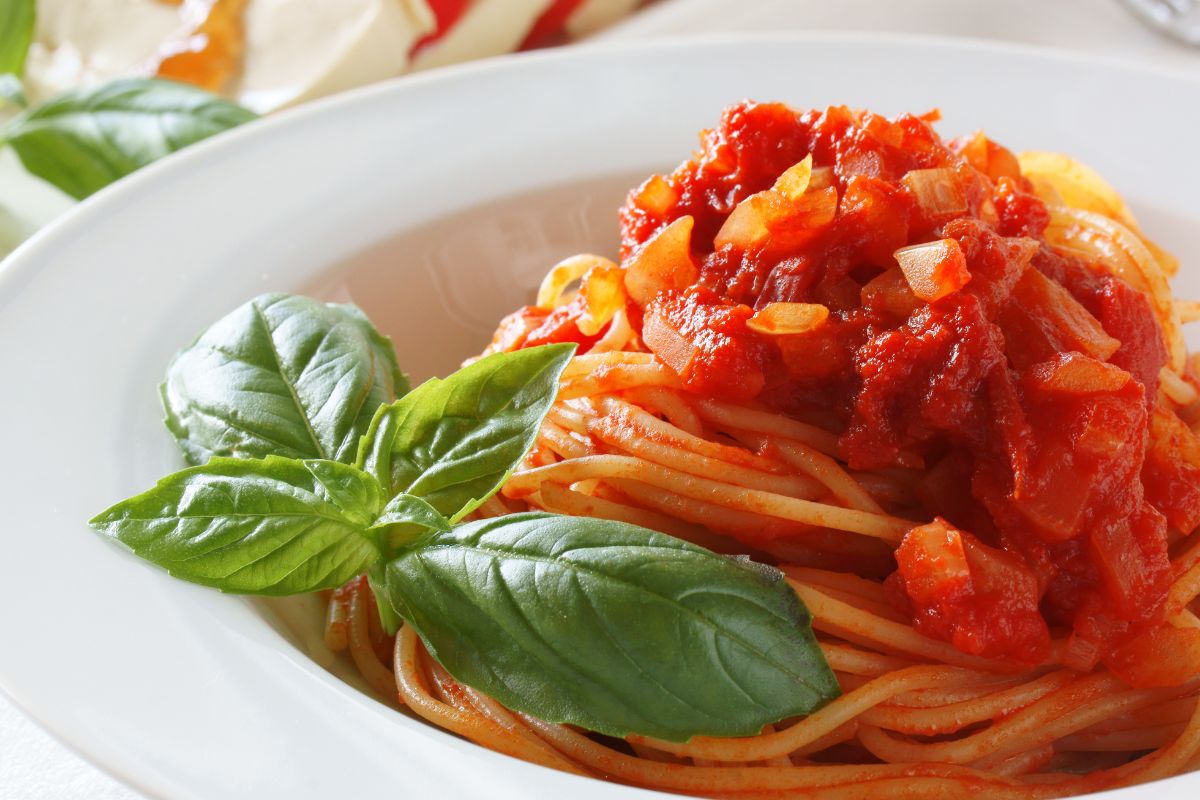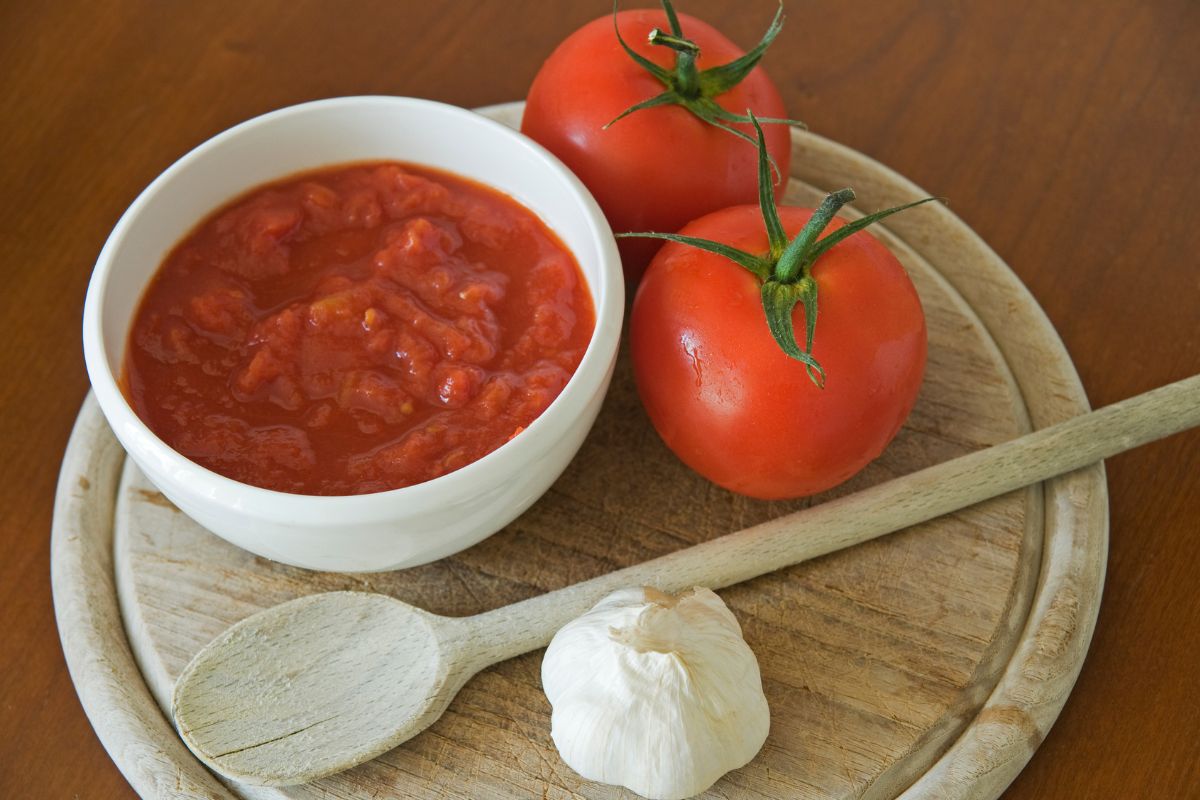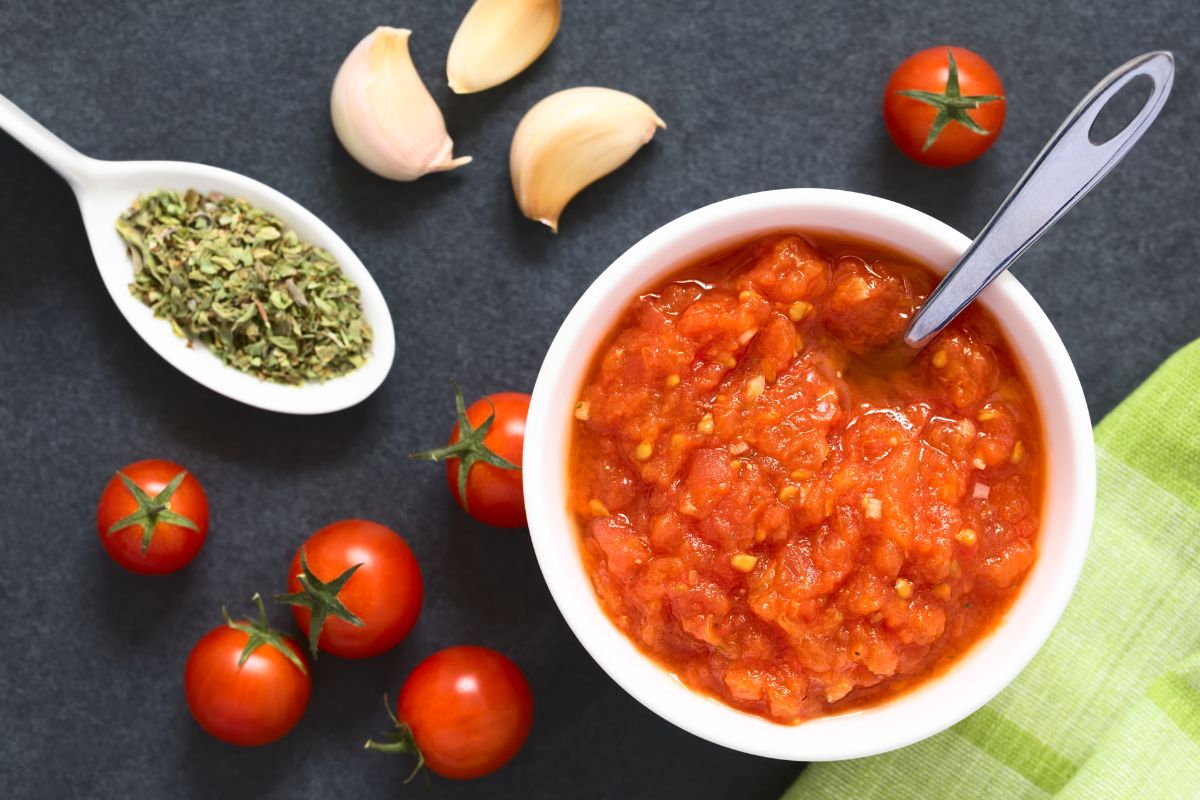Whether you are new to cooking or a seasoned home cook, having a delicious sauce for your main dish is the way to go. So, what is Pomodoro sauce? Pomodoro is the Italian word for tomato. Therefore, Pomodoro sauce is a simple classic Italian tomato-based recipe with few ingredients.
Surprisingly, Pomodoro also means “golden apple” because of the golden-yellow color of the traditional fresh juicy tomatoes used to make this sauce. Let’s find out more.

The Definition of Pomodoro Sauce
We can define Pomodoro sauce as a native Italian fleshy, juicy tomato-based sauce used in salads, pasta, meat, etc. This sauce not only tastes great when served with pasta but also serves as an excellent foundation for dishes like braciole and chicken parmesan. It is a delicious starting sauce for numerous Italian dishes.
Pomodoro sauce has just a few ingredients, which is one of the reasons why it is so wonderful. Like any other simple recipe, your dish will be exceptional if the ingredients are fresh and delectable.
What is Pomodoro Sauce Made of?
Pomodoro sauce is a tomato-based sauce made of freshly diced tomatoes (usually San Marzano tomatoes), olive oil, garlic, and fresh basil. You can crush these tomatoes to produce a thick creamy texture.
Different Italian cuisines have variations of Pomodoro sauce ingredients, such as adding different fresh spices and herbs like dried oregano. For example, you can use this sauce as a meat sauce if you add proteins like ground beef, anchovies, or sausages. Also, you can add parmesan cheese to create a smooth and creamy Pomodoro sauce for pasta.
What is the Difference Between Marinara and Pomodoro Sauce?
Knowing the differences between marinara sauce and Pomodoro sauce is essential when choosing which to use as a dipping sauce or for your homemade pizza. Both are suitable for quick dinners during the week or comfort foods like homemade pasta.
These quick sauce recipes contain ingredients you can easily get at the grocery store. The ingredients include fresh tomatoes, kosher salt, black pepper, and extra virgin olive oil. They also take little preparation and cooking time. Here are three major differences between these two sauces:
Taste
Pomodoro and marinara sauce recipes contain comparable ingredients. For this reason, the differences in flavor between the two sauces are subtle and dependent on the specific ingredients you use.
Marinara typically has tomatoes, oregano, red pepper flakes, red wine, garlic, basil, and bay leaves as ingredients. These ingredients give the sauce a flavourful taste. On the other hand, this sauce has tomatoes, oregano, fresh garlic, and olive oil. This provides the sauce with a distinctive rich tomato taste.
The tomatoes you use to make these sauces might also affect their flavor. You can experiment with San Marzano or plum tomatoes in various marinara and Pomodoro sauce recipes to find the ideal flavor combination for your palette.
Texture
The texture is the primary distinction between these two dominant tomato sauces in Italy; marinara and Pomodoro. Marinara sauce requires simmering herbs and spices between 30 minutes and an hour to achieve that delicious red sauce texture.
Pomodoro, on the other hand, hardly qualifies as a sauce in comparison to marinara. It requires simmering chopped and crushed tomatoes with fresh garlic and olive oil for about 25 minutes. Pomodoro sauce is typically thicker due to the base of crushed tomatoes used.
Application
Some home cooks prefer Pomodoro sauce for pizza sauce because it is less watery and more spreadable. On homemade pasta meals like lasagna, spaghetti, gnocchi, ravioli, or chicken parmesan, or on a low-carb zucchini bake, both marinara and Pomodoro sauces go well.
The two sauces are different even though some of these ingredients appear in both. However, since the recipes can differ, everything depends on the precise sauces you’re working with. Your meals taste much better if you select high-quality Pomodoro or marinara ingredients.

Our Favorite Pomodoro Sauce Recipe
There’s nothing more fulfilling for Italian food lovers than knowing how to make Pomodoro sauce. Check out our simple Pomodoro recipe here:
Pomodoro Sauce Recipe
Time: 30 minutes
Serving size: 4 to 6 servings
Prep time: 5 minutes
Cook time: 25 minutes
Nutritional Facts
- Calories: 63 calories
- Protein: 0.042 ounces (1.2 grams) (2.3%)
- Carbohydrates: 0.18 ounces (5.2 grams) (1.7%)
- Fat: 0.17 ounces (4.8 grams) (7.5%)
- Saturated fat: 0.024 ounces (0.7 grams) (3.3%)
- Sugars: 0.12 ounces (3.4 grams)
- Sodium: 0.011 ounces (0.32 grams) (13.4%)
- Fiber: 0.1 ounces (2.6 grams) (10.3%)
Equipment Needed
- Large saucepan or Dutch oven
- Mortar and pestle
- Cutting board
- Sharp knife
- Immersion blender
Ingredients
- 3 cloves garlic
- 1 (28-ounce (794 grams)) can of whole peeled tomatoes
- 2 tablespoons olive oil
- 1 large sprig of fresh basil (optional)
- ¼ teaspoon freshly ground black pepper
- 1 teaspoon kosher salt
Directions
- Peel and crush three garlic cloves using the mortar and pestle.
- Put two tablespoons of olive in a large saucepan or Dutch oven and simmer over medium heat.
- Add the crushed garlic and cook for one to two minutes until it produces an aroma and turns lightly golden.
- Put in one 28-ounce (794 grams) can of whole, peeled tomatoes. Add one large fresh basil leaf and season with ¼ teaspoon black pepper and one teaspoon kosher salt before stirring. Let it simmer while covered.
- Turn down the heat to medium-low, uncover the pot, and simmer until the sauce turns slightly thick. At this point, use a wooden spoon to gently mash the tomatoes as they soften for about 20 minutes.
- Turn off the heat and remove the pot. Remove the basil sprig. With your mixture still in the pot, use an immersion blender to blend the ingredients until fully smooth. Alternatively, pour the mixture into a stand blender and puree it until completely smooth.
Your Pomodoro sauce is ready to serve.
Notes: You can prepare the Pomodoro sauce up to a day ahead of time and store it in a freezer or refrigerator for up to three months. Before reheating frozen sauce over medium heat, let it defrost overnight in the refrigerator. For storage, you can keep the leftover sauce in the fridge for about five days in an airtight container.
Italian Dishes to Serve With Pomodoro Sauce
Pomodoro sauce is an easy-to-prepare classic Italian sauce that goes with most dishes. The most common dish served with Pomodoro sauce is pasta. You can serve it with short pasta dishes like penne or long pasta dishes like spaghetti. You can also use it to coat cooked noodles.
Additionally, you can use this adaptable sauce as the foundation for many Italian cuisines, including layered lasagnas or chicken parmigiana. Simple Pomodoro sauce is great for use as a topping for chicken breasts with a little melted mozzarella.
Pomodoro sauce goes well with pizza too! If you are a pizza lover, feel free to use this sauce on your slices.
Is Pomodoro Sauce Vegan-Friendly?
Yes! Since Pomodoro sauce is made entirely of crushed tomatoes and other natural ingredients (garlic, basil, and olive oil), it is naturally vegan-friendly. This sauce is gluten-free, dairy-free, and grain-free, as long as you avoid the meat-added and creamy varieties.
The Difference Between Spaghetti and Pomodoro Sauce
In comparison, spaghetti sauce and Pomodoro sauce have notable differences. For instance, while Pomodoro sauce boasts simplicity with crushed tomatoes, spaghetti sauce often contains minced meat or meatballs.
Another fundamental distinction between the two sauces is that Pomodoro sauce is thicker and smoother than spaghetti sauce.
Is Pomodoro Sauce Good for You?
Yes! Pomodoro sauce is good for you and packs plenty of benefits essential for your body. Here are a few amazing health benefits of Pomodoro sauce:
- It improves digestive health
- It improves heart health
- It’s a rich source of essential vitamins
- It improves gut health
Are Pomodoro Sauces Spicy?
Pomodoro sauce isn’t spicy because it usually doesn’t contain red pepper flakes. The vibrant and flavorful sauce allows the tomatoes to stand out. Although, while it simmers, you can add a pinch of red pepper flakes if you prefer a little heat.
Why is it Called Pomodoro Sauce?
Pomodoro is a sauce containing tomatoes as the foundation, literally meaning “golden apple” in Italian. The name comes from the fact that the first tomatoes in Italy were a shade of yellow that reminded people of their native apples.

A Short History Lesson About Pomodoro Sauce
The present Italian title for the sauce, “Pomodoro,” came from a Tuscan steward’s description of the tomato as a “pomi d’oro,” or “golden fruit,” in 1548. Although earlier assumptions that tomatoes were harmful, they eventually became a staple of Italian cuisine.
The fruit’s capacity to flavor meals contributed to its popularity, which was significant at a time when spices were expensive and difficult to come by. Italians started experimenting with tomato preservation techniques in the 18th century.
Tomatoes gained more popularity in the 19th century when Pomodoro sauce, pasta al Pomodoro, Margherita pizza, and other Italian cuisines came into vogue. As these recipes gained popularity, Italy started its process of unification, aiding in the dissemination of these foods as well as other culinary methods.
Conclusion
You have all you need to make this classic Italian sauce if you have tomatoes, olive oil, basil, and garlic. The Pomodoro sauce recipe allows the flavor of the tomatoes to stand out rather than getting obscured by numerous additives.
The tomatoes get simmered quickly to retain their brightness. Mixing this blended sauce with spaghetti or any other preferred pasta, you can make a simple dish.

Community of passionate writers and content creators who share a love for Italian heritage, culture, travel, food, and the Italian-American community. Our mission is to celebrate Italy’s rich history and traditions and connect with others who share the same passion.

